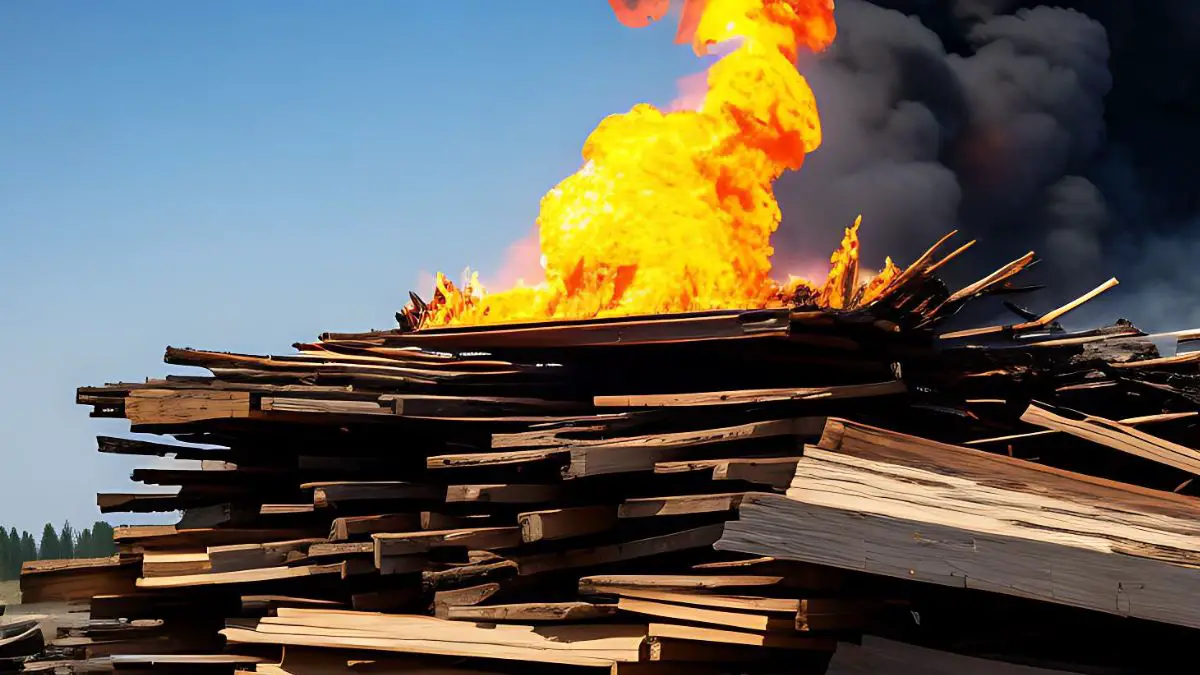Staining is a common way to enhance the look of wood, but what happens if you want to burn it?
The question of whether it’s safe to burn stained wood arises frequently, as people wonder about the possible release of harmful chemicals and toxic fumes.
In this article, we’ll address the question “Can you burn stained wood?” by exploring the chemistry behind different types of wood stains, the potential hazards of burning stained wood, and how to safely dispose of it!
Ready to rock?
Types of Stained Wood
Stained wood is wood that has been treated with a colored, protective coating.
The coating can be applied in many ways, such as using a brush, spray, or roller. It can also be applied directly onto the wood or by staining a piece of wood before it is used.
Different types of stains include:
- Oil-based: Oil-based stains are made from natural oils known for their durability and color intensity.
- Water-based: Water-based stains are more difficult to apply but offer a more even finish and are known for their ability to resist fading.
- Synthetic: Synthetic stains are artificial and offer an array of colors not found in natural stains. Staining wood can protect the wood while also making it look more attractive.
However, it is important to be aware of the risks associated with burning stained wood, as the chemicals in the stain can be released into the air and cause respiratory problems.
Risks of Burning Stained Wood
Burning stained wood can be hazardous to your health and the environment. The following are some of the risks associated with burning stained wood:
- Toxic Fumes: When stained wood is burned, it releases toxic fumes that can harm human health. These fumes contain various harmful chemicals, such as formaldehyde, carbon monoxide, and volatile organic compounds (VOCs).
- Air Pollution: Burning stained wood also contributes to air pollution, which can have serious environmental consequences. The pollutants released into the air can cause respiratory problems, worsen existing health conditions, and harm plants and wildlife.
- Creosote Buildup: Burning stained wood can also lead to the buildup of creosote in your chimney or flue. Creosote is a highly flammable substance that can cause chimney fires if not removed regularly.
- Legal Consequences: Burning certain types of wood, such as chemically-treated or painted wood, can be illegal and may result in fines or other legal consequences.
Alternatives to Burning Stained Wood
If you have stained wood that you cannot burn or prefer not to burn, there are plenty of other methods you can try out instead:
- Recycling: Depending on the type of wood, it may be recyclable. Check with your local waste management facility to see if they have a wood recycling program.
- Landfill: If the wood is not recyclable, it can be disposed of in a landfill. Check with your local waste management facility for guidance on the proper disposal of the wood.
- Reuse: Consider using the wood for a different purpose, such as making a birdhouse or a garden planter.
- Donate: If the wood is still in good condition, consider donating it to a local community center, school, or charity that can use it for their projects.
- Composting: If the untreated wood can be shredded and added to a compost pile.
Regardless of your chosen alternative method, it’s important to properly dispose of the wood to prevent environmental pollution and protect public health.
Legal Consequences
Several laws and regulations may prohibit the burning of stained wood. For example, many states have laws that prevent the release of toxic chemicals into the air.
You could be fined or jailed if you are burning stained wood violating these laws.
Check out a few of our states’ burning laws below!
Ohio open burning laws
Open burn laws in Ohio prohibit the burning of hazardous materials ( including chemically treated wood).
Chemically treated wood may contain dangerous chemicals like arsenic, chromium, and copper, which can be released into the air during burning and severely threaten humans and the environment.
Breaking Ohio’s open burn laws could lead to fines of up to $10,000, depending on the severity of the violation.
Tennessee open burning laws
In Tennessee, open burning is regulated by the Tennessee Department of Environment and Conservation (TDEC) under the Open Burning Regulations (Rule 1200-3-18).
Burning any materials that produce dense smoke or noxious odors is prohibited, and certain materials such as rubber, plastic, and petroleum products are not permitted from burning altogether.
Regarding burning stained wood specifically, it is not explicitly addressed in the regulations.
However, if the wood has been treated with chemicals or paint, it is considered prohibited and should not be burned.
If the wood has only been stained, it may be allowed to be burned as long as it does not produce dense smoke or noxious odors.
Frequently Asked Questions (FAQs)
Is varnish toxic when burned?
While varnish is generally safe to use and handle, burning it can release potentially harmful fumes. We don’t recommend it.
What wood should not be burned?
Examples of wood that should not be burned include pressure-treated wood, plywood, particleboard, and any wood that has been painted, stained, or treated with chemicals.
Is wood stain flammable after it dries?
Most wood stains are flammable after they dry because their solvents are highly flammable. Even after the solvents have evaporated, the pigmented coating can still be flammable if exposed to high heat or flames.
Can I burn stained cedar?
Burning stained cedar is not recommended because cedar is a softwood that generates a considerable amount of creosote when burned.
Wrapping it Up
To avoid the hazards associated with burning stained wood, it is essential to seek alternative uses.
Moreover, being aware of the open burning laws in your state can prevent any legal issues.
By finding other purposes for stained wood, you can still benefit from its aesthetic appeal while minimizing risks to your health and the environment.

